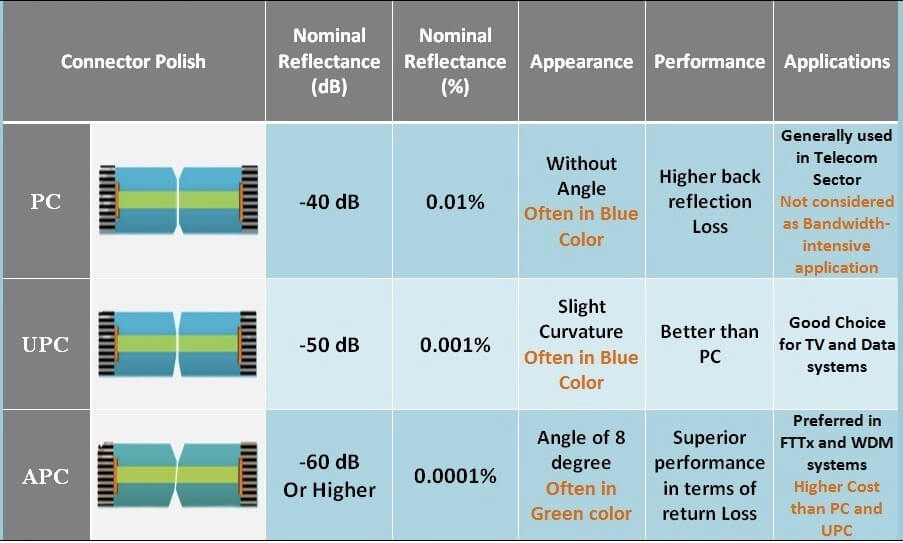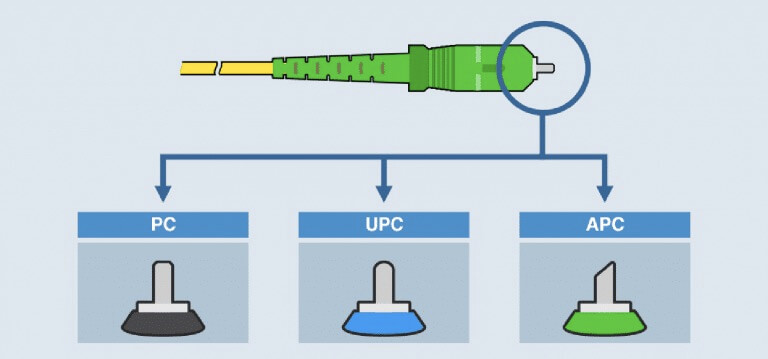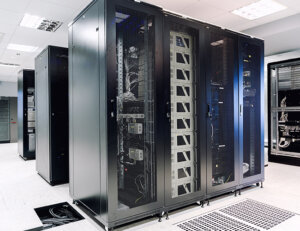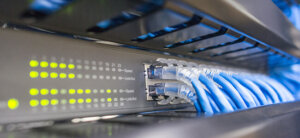When installing a connector on a fiber end face, return loss is unavoidable, which is caused by the reflection of the light source. Severe light loss can damage the laser light source and interrupt the transmitted signal. In order to allow better contact between the end faces of the two optical fibers, the end faces of the ferrule of the fiber optic jumper are usually ground into different structures.
What are the fiber connector polish types?
Common fiber connector polish types include PC, UPC, and APC.
PC (Physical Contact): Microsphere grinding and polishing, the surface of the ferrule is ground into a slightly spherical surface, and the fiber core is located at the highest bending point, which can effectively reduce the air gap between the fiber optic components and make the two fiber end faces reach physical contact.
UPC (Ultra Physical Contact): The end face of the UPC connector is not completely flat, there is a slight curvature to achieve a more precise docking. On the basis of PC, UPC has optimized the end face polishing and surface finish, and the end face looks more dome-shaped.
APC (Angled Physical Contac) is an inclined physical contact. The fiber end face is usually ground into an 8° bevel. The 8° angle bevel makes the fiber end face tighter and reflects light to the cladding through its bevel angle instead of directly returning to the light source, providing better connection performance.

What are the differences between fiber connector polish types?
- Appearance
Both PC and UPC fiber optic connectors belong to the non-angle polishing method, and the end faces are arc-shaped, but the UPC fiber optic connector optimizes the end face polishing and surface finish on the basis of PC fiber optic connectors, so the end face is slightly larger. It is dome-shaped, while the APC fiber optic connector is beveled and polished, and the end face is usually ground at an angle of 8 degrees.
Another obvious difference is the color, we can distinguish the type of fiber optic connector by its color. Generally, PC and UPC fiber optic connectors are blue, and APC fiber optic connectors are green. - Performance
Different grinding methods determine the quality of optical fiber transmission, mainly reflected in insertion loss and return loss.
In general, the typical insertion loss of PC, UPC and APC connectors should be less than 0.3dB. Compared to APC connectors, it is generally easier to achieve low insertion loss with UPC/PC connectors due to the smaller air gap. Insertion loss can also be caused by dust particles between the connector end faces.
The end face of the APC connector is bevel polished, so the return loss of the APC connector is usually better than that of the UPC connector. In general, the return loss of the optical fiber jumper using PC grinding method is -40dB. UPC return loss is higher than that of PC, generally at -55dB. The APC industry standard return loss is -60dB.
When using the UPC connector, part of the reflected light will be emitted back to the light source, and the inclined end face of the APC connector will reflect part of the reflected light to the cladding at a certain angle, thereby reducing more reflected light back to the light source. This is the main factor causing the difference in return loss. - Application
PC used to be the most common grinding method for fiber optic connectors on fiber optic jumpers. Since the UPC connector has a higher return loss than the PC connector, it completely replaced the PC connector.
UPC is usually used in Ethernet network equipment (such as ODF optical fiber distribution frame, media converter and optical fiber switch, etc.), digital, cable TV and telephone systems, etc. Due to the greater return loss of the APC connector, it is suitable for use in optical communication systems that require higher return loss.
APC is generally used in optical radio frequency applications in high wavelength range such as CATV, and also in optical passive applications, such as PON network structure or passive optical local area network.

Summary
The size of APC and UPC connectors with the same interface is basically the same. Although they can be connected physically, due to the difference in the end faces of the pins, the insertion loss after connection is large (more than 4.0dB). Therefore, APC and UPC connectors cannot be mixed. Currently, UPC active connections are generally used in optical distribution equipment of operators. With the increase in the use of communication systems with a line pattern of PAM4 and WDM systems using Raman fiber amplifiers, the shortcomings of UPC active connections are increasingly exposed, and optical fiber active connectors should transition from UPC to APC as soon as possible.




